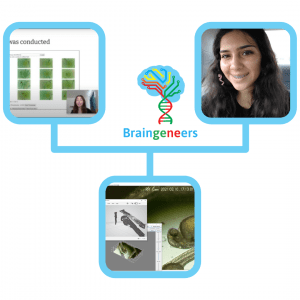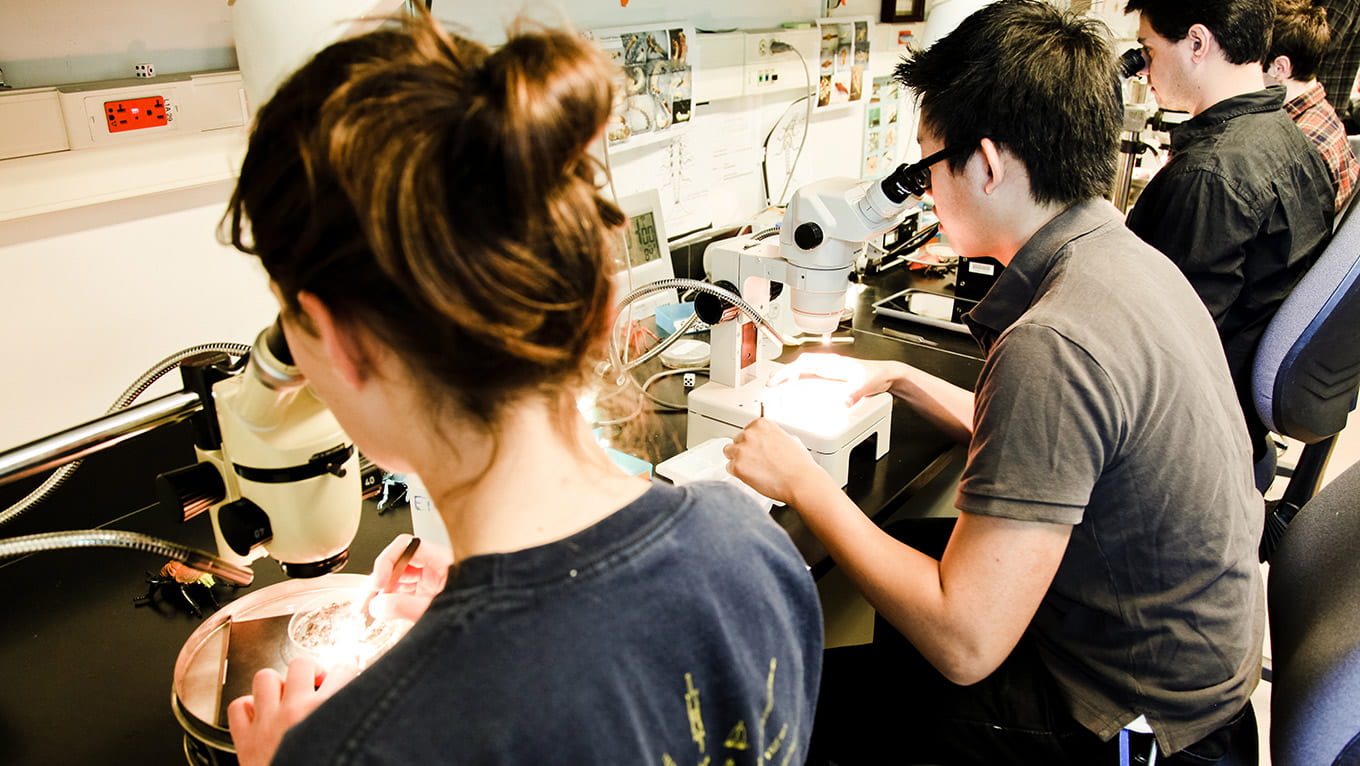SANTA CRUZ, CA – June 23, 2021 – Fall quarter 2020, UC Santa Cruz Genomics Institute’s Scientific Director David Haussler had an inspiration: “Let’s use our Picroscope to introduce Alisal High students to research!” With that, the Genomics Institute Office of Diversity was on its way to piloting a remote teaching project in an Advanced Placement® (AP) biology class at Alisal High School in Salinas, California, located about an hour’s drive south of Santa Cruz.
What is the Picroscope? It’s a low-cost 3D camera system developed during the pandemic by UCSC and UCSF faculty and graduate students. The Picroscope, which is under patent review, is an inexpensive tool designed to enable basic scientific study, and created by researchers interested in solving the problem of how to observe microscopic biological changes from a distance.
The pandemic suddenly presented the perfect opportunity to put the Picroscope through its paces as a foundational tool of scientific inquiry and education.
The Picroscope can be set up at a lab and then be used for remote observation, e.g. from home, which is a huge benefit given the need for remote work during this pandemic. Perhaps best of all, it is designed to be affordable and DIY – something an aspiring researcher could build using off-the-shelf and 3D-printed materials. In fact, the UC Picrocope developers have shared a preprint publication, Development of a Low-Cost System for Simultaneous Longitudinal Biological Imaging, detailing its design and providing instructions on how to make one.
Recently, Alisal students were discussing what they saw through the scope. “One of them shared that they can see a dose-dependent difference in fin and tail development of zebrafish exposed to ammonium nitrate, a hazardous chemical found in fertilizers,” said Mohammed Mostajo-Radji, a Harvard-trained neuroscientist who has recently joined the UCSC Genomics Institute and is a key contributor to the Alisal collaboration.

According to Mostajo-Radji, this was an aha moment, highlighting a direction that students might take their research in order to better understand biological impacts of environmental pollutants common in the South County area, the result of industrial agriculture.
“It was surreal to learn that I had noticed a difference in the fish’s tail development that seemed interesting to the UCSC scientists,” said junior Belinda Gallardo Barrows, the student who made the keen observation. “It was a thrilling idea that I was part of a REAL research project that could help my community,” Gallardo Barrows added.
This episode of scientific discovery was just the latest in a longstanding collaboration between UCSC and Alisal faculty. The Picroscope program started as a six week pilot in Fall 2020, becoming the springboard for a more fully realized curriculum featuring online teaching and experimentation with the Picroscope by Spring 2021.
Since the pilot’s completion, the team worked with teacher Rebecca Ward at Alisal to develop an educational module that was integrated into her AP biology class. The first class of their eight-week Picroscope-focused curriculum was on February 2, 2021.
According to Ward, what has been especially valuable about the Picroscope project is that “it has allowed students to feel the expectations and excitement of university level research.” The collaboration has “definitely added to Alisal students’ AP experience by allowing them to work with and talk to graduate students in different stages of their scientific careers,” Ward elaborated.
Junior Gallardo Barrows confirmed that she was “inspired by the graduate students that helped us through the project,” adding that “they are role-models for me, and their excitement surrounding research and science was contagious.”
“The kids have now seen firsthand that you could do research as a career,” Ward said. “For one student, who was thinking about doing research as a career, this has cemented her desire.”
The kernel of inspiration for this ongoing UCSC-Alisal collaboration has been to foster diversity, equity and inclusion in STEM, and the Genomics Institute’s Office of Diversity team has been a proponent of that effort.
“The UCSC-Alisal collaboration has been an incredible opportunity to push the boundaries of what is possible at the Genomics Institute in Santa Cruz,” said Sandra M. Ramirez, former Program Coordinator of the Genomics Institute Office of Diversity. “It’s shown us how we can continue to use even modest resources to create a more equitable and inclusive science environment for all of our inspiring scientists,” Ramirez added, noting that the Picroscope technology means that even distance does not have to be an obstacle.
“Throughout the incredible hardship the students have faced with remote learning and the pandemic, their eagerness to participate and excitement about learning has been inspiring,” said Atesh Worthington, a 5th year PhD candidate in UCSC’s Forsberg Lab, who was pivotal in helping the teaching team think through the structure and delivery of the learning module, as well as responsible for creating lesson plan templates and student exercises for the module instructors to deliver.
“I really enjoyed working together with my fellow graduate student instructors and the Institute to create a program from scratch to connect the Alisal students to research happening in their own communities,” Worthington said. “It has also been very rewarding to interact with the Alisal students and to design interactive, engaging lessons with a focus on equitable and inclusive pedagogical practices,” she added.
Coordinated by Ramirez, this UCSC-Alisal collaboration was made possible with Ward’s oversight and enthusiasm. “We could not have done this without Ms. Ward opening her classroom and willingness to revise her class curriculum to incorporate the Picroscope,” said Ramirez.
Haussler lab graduate student Kateryna Voitiuk agreed and added that the project has been meaningful for everyone involved. “We worked really hard to build the technology and I’m inspired that we can bring it to students and make their learning experience memorable,” she emphasized.
At UCSC and UCSF, researchers use this system for data gathering in a range of scientific studies in several labs, including UCSC’s Haussler-Salama Lab; UCSC’s Teodorescu lab, UCSF’s Nowakowski Lab, and UCSF’s Pollen Lab, all collaborating in a neuroscience team called the Braingeneers.
“Using this tool, we can measure the behavior of entire organisms or individual cells over long time periods,” explained Victoria Ly, a Braingeneers team graduate student.
Applications include collecting whole organism 3D images showing developmental changes in frogs, fish and worm embryos as well as live tissue culture models including cerebral organoids – structures grown in the lab that mimic patches of brain tissue of a developing embryo – to study human brain development. You can see a video produced by the Fall 2020 pilot program exploring the effect of caffeine on zebrafish here.
Those helping with this project include Mostajo-Radji; UCSC graduate students Victoria Ly and Pierre Baudin, who have helped develop the Picroscope, UCSC graduate student Aviv Elor, who is working on integrating extended features; UCSC graduate student Atesh Worthington, who is leading lesson plan development; UCSC graduate students Kate Voitiuk and Ryan Hoffman, who do the classroom lectures along with Ly, Baudin, and Worthington; and UCSC undergraduate student Lupe Martinez, who is supporting students by holding office hours dedicated to digging more deeply into key concepts and questions raised by their observations of the developing organisms.
“It’s all very cool and the science is cutting-edge,” Haussler said. “It also provides access to a level of technology that the Alisal students would not otherwise have available, so it could be a game changer for rural and underfunded high schools, helping to level the playing field in STEM education” he said.
As a result of the success of the Alisal collaboration, UCSC’s team looks forward to introducing this curriculum to other high schools regionally and internationally.
– SHARE THIS STORY –
You May Also Be Interested In
-

2025 Dean’s Awards highlight outstanding Baskin Engineering undergraduate research in AI, cybersecurity, biomedicine, and more
-

Baskin Engineering students sweep SC Launchpad 2025 awards in technology and social impact categories
-

Computer engineering student develops AI tool to streamline grading and enhance learning

